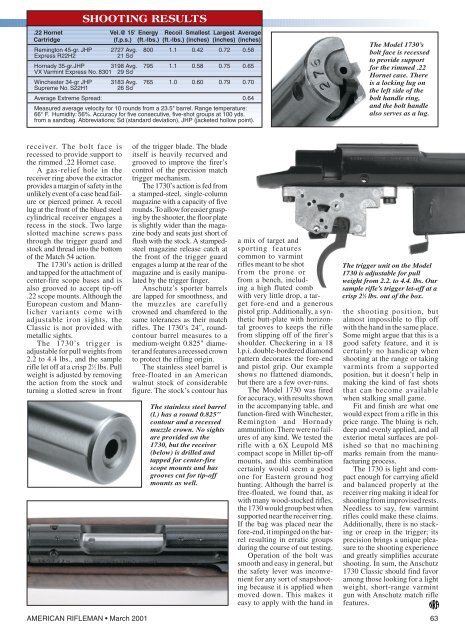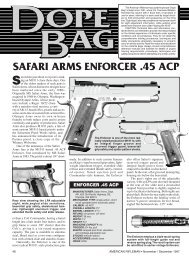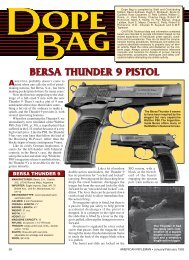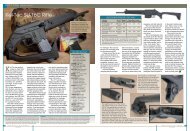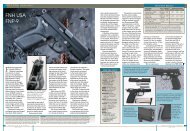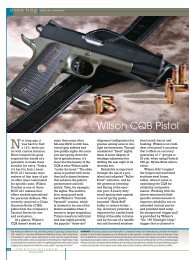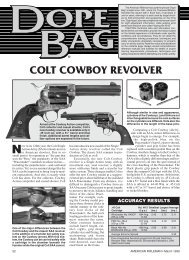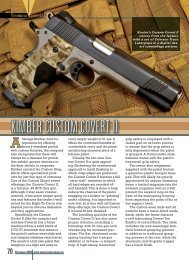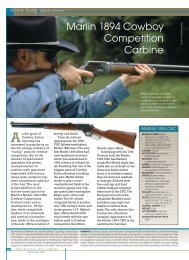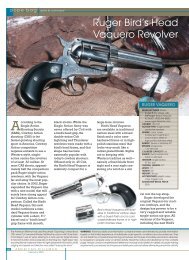CZ 75B SA Pistol
Download AR Dope Bag March 2001 - The National Firearms Museum
Download AR Dope Bag March 2001 - The National Firearms Museum
- No tags were found...
Create successful ePaper yourself
Turn your PDF publications into a flip-book with our unique Google optimized e-Paper software.
SHOOTING RESULTS<br />
.22 Hornet Vel.@ 15' Energy Recoil Smallest Largest Average<br />
Cartridge (f.p.s.) (ft.-lbs.) (ft.-lbs.) (inches) (inches) (inches)<br />
Remington 45-gr. JHP 2727 Avg. 800 1.1 0.42 0.72 0.58<br />
Express R22H2<br />
21 Sd<br />
Hornady 35-gr.JHP 3198 Avg. 795 1.1 0.58 0.75 0.65<br />
VX Varmint Express No. 8301 29 Sd<br />
Winchester 34-gr JHP 3183 Avg. 765 1.0 0.60 0.79 0.70<br />
Supreme No. S22H1 26 Sd<br />
Average Extreme Spread: 0.64<br />
Measured average velocity for 10 rounds from a 23.5" barrel. Range temperature:<br />
66° F. Humidity: 56%. Accuracy for five consecutive, five-shot groups at 100 yds.<br />
from a sandbag. Abbreviations: Sd (standard deviation), JHP (jacketed hollow point).<br />
The Model 1730’s<br />
bolt face is recessed<br />
to provide support<br />
for the rimmed .22<br />
Hornet case. There<br />
is a locking lug on<br />
the left side of the<br />
bolt handle ring,<br />
and the bolt handle<br />
also serves as a lug.<br />
receiver. The bolt face is<br />
recessed to provide support to<br />
the rimmed .22 Hornet case.<br />
A gas-relief hole in the<br />
receiver ring above the extractor<br />
provides a margin of safety in the<br />
unlikely event of a case head failure<br />
or pierced primer. A recoil<br />
lug at the front of the blued steel<br />
cylindrical receiver engages a<br />
recess in the stock. Two large<br />
slotted machine screws pass<br />
through the trigger guard and<br />
stock and thread into the bottom<br />
of the Match 54 action.<br />
The 1730’s action is drilled<br />
and tapped for the attachment of<br />
center-fire scope bases and is<br />
also grooved to accept tip-off<br />
.22 scope mounts. Although the<br />
European custom and Mannlicher<br />
variants come with<br />
adjustable iron sights, the<br />
Classic is not provided with<br />
metallic sights.<br />
The 1730’s trigger is<br />
adjustable for pull weights from<br />
2.2 to 4.4 lbs., and the sample<br />
rifle let off at a crisp 2 1 ⁄2 lbs. Pull<br />
weight is adjusted by removing<br />
the action from the stock and<br />
turning a slotted screw in front<br />
of the trigger blade. The blade<br />
itself is heavily recurved and<br />
grooved to improve the firer’s<br />
control of the precision match<br />
trigger mechanism.<br />
The 1730’s action is fed from<br />
a stamped-steel, single-column<br />
magazine with a capacity of five<br />
rounds. To allow for easier grasping<br />
by the shooter, the floor plate<br />
is slightly wider than the magazine<br />
body and seats just short of<br />
flush with the stock. A stampedsteel<br />
magazine release catch at<br />
the front of the trigger guard<br />
engages a lump at the rear of the<br />
magazine and is easily manipulated<br />
by the trigger finger.<br />
Anschutz’s sporter barrels<br />
are lapped for smoothness, and<br />
the muzzles are carefully<br />
crowned and chamfered to the<br />
same tolerances as their match<br />
rifles. The 1730’s 24", roundcontour<br />
barrel measures to a<br />
medium-weight 0.825" diameter<br />
and features a recessed crown<br />
to protect the rifling origin.<br />
The stainless steel barrel is<br />
free-floated in an American<br />
walnut stock of considerable<br />
figure. The stock’s contour has<br />
The stainless steel barrel<br />
(l.) has a round 0.825"<br />
contour and a recessed<br />
muzzle crown. No sights<br />
are provided on the<br />
1730, but the receiver<br />
(below) is drilled and<br />
tapped for center-fire<br />
scope mounts and has<br />
grooves cut for tip-off<br />
mounts as well.<br />
a mix of target and<br />
sporting features<br />
common to varmint<br />
rifles meant to be shot<br />
from the prone or<br />
from a bench, including<br />
a high fluted comb<br />
with very little drop, a target<br />
fore-end and a generous<br />
pistol grip. Additionally, a synthetic<br />
butt-plate with horizontal<br />
grooves to keeps the rifle<br />
from slipping off of the firer’s<br />
shoulder. Checkering in a 18<br />
l.p.i. double-bordered diamond<br />
pattern decorates the fore-end<br />
and pistol grip. Our example<br />
shows no flattened diamonds,<br />
but there are a few over-runs.<br />
The Model 1730 was fired<br />
for accuracy, with results shown<br />
in the accompanying table, and<br />
function-fired with Winchester,<br />
Remington and Hornady<br />
ammunition. There were no failures<br />
of any kind. We tested the<br />
rifle with a 6X Leupold M8<br />
compact scope in Millet tip-off<br />
mounts, and this combination<br />
certainly would seem a good<br />
one for Eastern ground hog<br />
hunting. Although the barrel is<br />
free-floated, we found that, as<br />
with many wood-stocked rifles,<br />
the 1730 would group best when<br />
supported near the receiver ring.<br />
If the bag was placed near the<br />
fore-end, it impinged on the barrel<br />
resulting in erratic groups<br />
during the course of out testing.<br />
Operation of the bolt was<br />
smooth and easy in general, but<br />
the safety lever was inconvenient<br />
for any sort of snapshooting<br />
because it is applied when<br />
moved down. This makes it<br />
easy to apply with the hand in<br />
The trigger unit on the Model<br />
1730 is adjustable for pull<br />
weight from 2.2. to 4.4. lbs. Our<br />
sample rifle’s trigger let-off at a<br />
crisp 2 1 ⁄2 lbs. out of the box.<br />
the shooting position, but<br />
almost impossible to flip off<br />
with the hand in the same place.<br />
Some might argue that this is a<br />
good safety feature, and it is<br />
certainly no handicap when<br />
shooting at the range or taking<br />
varmints from a supported<br />
position, but it doesn’t help in<br />
making the kind of fast shots<br />
that can become available<br />
when stalking small game.<br />
Fit and finish are what one<br />
would expect from a rifle in this<br />
price range. The bluing is rich,<br />
deep and evenly applied, and all<br />
exterior metal surfaces are polished<br />
so that no machining<br />
marks remain from the manufacturing<br />
process.<br />
The 1730 is light and compact<br />
enough for carrying afield<br />
and balanced properly at the<br />
receiver ring making it ideal for<br />
shooting from improvised rests.<br />
Needless to say, few varmint<br />
rifles could make these claims.<br />
Additionally, there is no stacking<br />
or creep in the trigger; its<br />
precision brings a unique pleasure<br />
to the shooting experience<br />
and greatly simplifies accurate<br />
shooting. In sum, the Anschutz<br />
1730 Classic should find favor<br />
among those looking for a light<br />
weight, short-range varmint<br />
gun with Anschutz match rifle<br />
features.<br />
AMERICAN RIFLEMAN • March 2001 63


